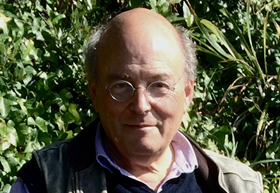Tributes have poured in for Simon Harris, the development consultant remembered as a driving force behind some of the City of London’s most celebrated office buildings.

Harris, who died last week following a long illness, co-founded Baker Harris Saunders in 1976, which became one of the most successful agency practices of the boom years of the 1980s. In 1994, following the firm’s merger with Herring Son & Daw, Harris and fellow founder Michael Baker quit to form BH2, where he remained until 2001.
His first major project was Cutlers Gardens, on the edge of Spitalfields. In a move described by Baker as a “masterstroke”, Harris persuaded the Post Office to change the postcode from E1 to EC2, “a proper City postcode”, because the site occupied a small part of Devonshire Square.
Harris went on to work on many of the City’s landmark office buildings including One Finsbury Square, One Poultry and 30 St Mary Axe (The Gherkin).
Tony Gibbon, who worked closely with Harris at BH2 during the 1990s, remembers the pivotal role Harris played in bringing The Gherkin to fruition.
“When his team produced the initial designs for St Mary Axe everybody was taken aback but our client (the late Alan Winter of Trafalgar House) was ecstatic,” he said. “Simon persuaded Peter Rees (the former City of London chief planning officer) to back the proposal and the rest is history. Many other developers ‘piggy backed’ on this idea of tall buildings and continue to do so.”
Rees recalls how Harris attended so many planning negotiation meetings “it seemed as if he had moved into my office”. Armed with a sketchbook and fountain pen, Harris would quietly take notes and doodle solutions to design issues under discussion, he said.
“Not only would he have sketched out a solution to the intractable problem but he would be able to ‘remind’ us of what we had said, from his careful notes of the negotiation. That was Simon Harris, the City’s ‘Agent Provocateur’.”
Belief in good architecture
Harris was best known for his belief in the importance of good architecture and his focus on designing buildings from the occupiers’ point of view.
“In my view he was unique in the City property market and was perhaps the first surveyor to understand the fact that good architecture and design was welcomed by the tenants and also made sound financial sense,” said Baker.
Digby Flower, chairman UK & Ireland at Cushman & Wakefield, who worked with Harris in his first job at Baker Harris Saunders, said: “It now seems commonplace to start designing buildings from the occupiers’ perspective but Simon was one of the first to realise this.”
Several leading architects and developers paid tribute to Harris’s professional legacy.
“His analysis, love of architecture and detail and knowledge of tenant requirements enabled me to act with confidence in changing many of the traditions of City office buildings,” said Sir Stuart Lipton.
Ken Shuttleworth, Make Architects, said Harris combined “the rigours of the agency world with the sensitivity of the architectural and design world” and Sir Terry Farrell said he was always glad when Harris was appointed from the outset of a project because of “his creative inspiration and intelligence”.
Almacantar chief executive Mike Hussey, who worked with Harris on New Street Square and One New Change when he was at Land Securities, added: “Simon was a class above most advisors: quiet; respectful; humble and insanely knowledgeable on design issues.”
On a personal level, Harris is also remembered fondly by his peers.
“He was undoubtedly among the most likable and generous people I have had the pleasure of working with during my City career,” said Michael Cassidy, former chairman of policy and resources, Corporation of London.
Sandra Jones, a former BH2 partner, added: “In an industry that has been criticised for a male-dominated culture lacking in diversity, Simon treated everyone on merit and had the rare gift of emotional intelligence as well as an ability to make you believe that anything was possible.”
A memorial event to celebrate Harris’s life and his impact on London will be held in the autumn.
Tributes for Simon Harris (1948-2018)
- From Michael Baker, former partner: “I first met Simon in the early 70’s and we then formed Baker Harris Saunders in 1976 and then BH2 in 1994. In my view he was unique in the City property market and was perhaps the first surveyor to understand the fact that good architecture and design was welcomed by the tenants and also made sound financial sense. In many ways he was a frustrated architect but he had the unusual flair to fully understand the planning and development process and really was the first development consultant in private surveying practice. He knew personally all the main architects and designers and other professionals and as a result developers and institutions would employ him to advise on the identity of the professional team for a specific job which he would then take through the planning process to planning consent. The change of the postcode on Cutlers Gardens was a masterstroke but not the only one. For example, he spotted that Lee House in London Wall, then owned by MEPC, and situated on the north side of London Wall were considering redevelopment. Simon thought that a larger scheme spanning London Wall would be technically possible in engineering terms, sketched out a scheme with relatively unknown at the time Terry Farrell, took it to MEPC who adopted the proposal which more than doubled the net floor area. Simon was a one-off; interesting, enthusiastic, artistic, caring and thoughtful with a wicked sense of humour. He, despite his illness, carried on working for many years without a murmur, played the guitar and was an avid oarsman-a good friend and will be missed by many.”
- From Tony Gibbon, BH2: ”I first met Simon in 1987 and was immediately impressed by his ‘style’; he looked and sounded ‘the part’ and he was the most influential of all the City’s agency fraternity. Having successfully seen projects like Cutlers Gardens (BH2 later recommended a rebrand to ‘Devonshire Square’) and Finsbury Avenue to fruition he was ‘flying’ and was undoubtedly the driving force behind Baker Harris Saunders. Years later he confided that he had assumed that the mid to late eighties period would be the pinnacle of his career but that he had changed his view when, together with Michael Baker, we came together following the reverse takeover of (what had become) Herring Baker Harris by my own firm, Lambert Smith Hampton, in 1994. Having being deflated by what he called ‘events’ he felt re-energised by projects like The Baltic Exchange (soon to become The Gherkin) and One Poultry and even though he had struggled with illness he talked of his determination to ensure we were more successful than his old firm. When his team produced the initial designs for St Mary Axe everybody was taken aback but our client (the late Alan Winter of Trafalgar House) was ecstatic .
”Simon persuaded Peter Rees at The City to back the proposal and the rest is history. Many other developers ‘piggy backed’ on this idea of tall buildings and continue to do so. Simon came up with our (BH2) name (again, later copied by many others) and somehow negotiated the fabulous telephone number! He created a great working space within a horrible building (if only it were not so hot!) which was a magnet for the great and good as well as those who were forging reputations. Simon was utterly charming, a very capable marketing man with a sharp brain who had a particular interest in real estate development, more precisely the creation of places and business environments. He felt that the process of leasing a building began with the Architects appointment and his tireless promotion of quality led to our working on projects with the likes of Norman Foster, Rab Bennetts, Rafael Vinoly, Nick Grimshaw, Foggo’s, James Stirling, Eric Parry, Jean Nouvel and many others. He was decades ahead of his time and I often amused myself watching him explain to ‘large ego’s’ how things should be done.
“There can be no doubt that, led by Simon, BH2 ensured that the ‘old rules’ were broken and that rather duller buildings would have been constructed had it not been for his intervention. Simon was also commercial; we spent hours together discussing the links between design and finance. Being frank; we disagreed on only one thing - how we should expand our business and with whom. This should be on record! Suffice to say that, with the benefit of hindsight, he was right and I was wrong - he understood individual motivations far more clearly and predicted our (to be fatal) ‘flaws’. We have laughed about this in recent years and thankfully we rekindled our relationship post his retirement to the point where, once again, we would sit around figuring out how to assemble sites and what we’d done in the past. A twenty nine piece jigsaw that became a building in Gresham Street particularly comes to mind, not least as it enabled us, alongside the very capable Mike Hussey (of whom Simon thought very highly) to also piece together the site of The Walkie Talkie Building, thus ensuring yet another landmark. Few people understand what it means to create a business from a standing start and how to supplement one another’s weaknesses whilst ensuring that our clients’ interests were best served. Simon was a leader in that respect as he encouraged the less confident of us to believe in ourselves and to be forthright in our approach.
“Whilst the very large buildings in which we were involved will be the ‘common’ legacy, I have to say that one of the most far sighted comments that Simon made to me related to a couple of former estate agents with whom he was friendly ahead of our meeting them to walk over the old Companies House building in City Road (he’d told me the Cutlers Gardens change of postcode ‘story’ years before and so I was particularly happy to notice the sign ‘Oliver’s Yard EC2’ which enabled us to do it again) ;we went on to work with John Burns and Simon Silver on another ‘edgy’ project that nobody really wanted in Hatton Garden as well….. “the Derwent guys really get it” he said way back then. I hear the same weekly nowadays….just another sign that the great somehow find one another and that those of us who are less gifted should simply be delighted to have been hanging around the right place at the right time…….hopefully learning!” - From Sandra Jones, former partner in BH: ”Simon had an uncanny ability to read people and situations, looking anyone straight in the eye and seeing to their core, with little mercy for anyone who fell short of his expectations. To those who won his confidence, he gave complete loyalty. In an industry that has been criticised for a male-dominated culture lacking in diversity, Simon treated everyone on merit and had the rare gift of emotional intelligence as well as an ability to make you believe that anything was possible.
- From Sir Stuart Lipton: ”Working with Simon was a delight. His analysis, love of architecture and detail and knowledge of tenant requirements enabled me to act with confidence in changing many of the traditions of City office buildings. Simon was a good friend, calm in action and never better chatting about life as he drove his electric boat on the Thames near his home in Wargrave. A man I shall long remember and miss.”
- From Mike Hussey, chief executive at Almacantar: ”Simon advised me on the transformation of New Street Square, selecting Rab Bennetts, and on the appointment of Jean Nouvel at One New Change. Simon was a class above most advisors: quiet; respectful; humble and insanely knowledgeable on design issues. New Street Square was probably our most successful scheme at Land Sec and when it completed, Simon wrote to me and said: “Mike, you have no idea how talented you are… very few people would have taken my advice and then actually made it work!” He was humble and a quiet, experienced, genius who admired risk-takers and whilst not one himself, he was the most effective risk advisor I ever met.”
- From Michael Cassidy, former chairman of policy and resources, Corporation of London: ”Simon was the most influential figure on the design aspects of new commercial buildings in the City during the period after Big Bang in the mid-1980’s. Almost uniquely placed as one of the founder-partners of “go-to” firm Baker Harris Saunders, he specialised in melding the economics of optimising layout and efficiency with a shrewd eye for how buildings looked. Reserved and charming in manner, Simon epitomised the style of the sophisticated business adviser of the day. He loved his leisure moments at his beautiful Thames-side house with rowing cabin attached. He was undoubtedly among the most likable and generous people I have had the pleasure of working with during my City career.”
- From Peter Wynne Rees CBE, professor of places & City planning and former Chief Planning Officer, City of London: ”From the first hint of the City’s Big Bang in the mid-1980s, Simon was in the thick of the development revolution which resulted. He attended so many planning negotiation meetings at the Guildhall that it seemed as if he had moved into my office. Simon had his regular seat, in a corner and awkwardly out of my line of sight. Unobtrusively armed with a sketchbook and fountain pen he would take careful notes, interspersed with doodled solutions to the design issues under discussion. At critical moments of tension - within sometimes passionate debates between planner, client and architect - I would hear what sounded like a calm quiet voice within my head. It was Simon, from his corner near my elbow, proposing a clever compromise with well-practised apparent diffidence. Not only would he have sketched out a solution to the intractable problem but he would be able to “remind” us of what we had said, from his careful notes of the negotiation. That was Simon Harris, as the City’s “Agent Provocateur”.
”To know the real Simon one had to enter the world of “The Wind in the Willows”. In his natural riparian environment he was transformed from the shyly brave Mole into the hyperactive and resourceful character of Ratty. His Thames-side lawn, complete with a traditional gypsy caravan, slid down to the river’s edge and the boat house. This was the sacred place which contained his birch-bark canoes. While the highly-decorated caravan was a passing reference to the “Toads” of the City of London, the boat house was Ratty’s domain. The true Simon Harris only came alive at the water’s edge, - which is where his spirit will endure.” - From Ken Shuttleworth, Make Architects:”He managed to combine the rigours of the agency world with the sensitivity of the architectural and design world.”
- From Sir Terry Farrell: ”Simon was original and creative, from the naming of a project to the location of the front door. He was able to turn projects around completely and in doing so be a critical and leading part of the creative team. I always was glad when he was appointed at the outset because of his creative inspiration and intelligence.”
- From Digby Flower, chairman UK & Ireland at Cushman and Wakefield: “My first job was at Baker Harris Saunders from 1985 to 1995. Working for Simon was a huge learning curve and great fun as long as you remembered three things - never be late, listen - you will only be told once, and be accurate and economical with words.It now seems commonplace to start designing buildings from the occupiers’ perspective but Simon was one of the first to realise this. We spent a lot time working on building designs and layouts with a tenants’ eye and testing these with Mick Bedford and Despina Katsikakis at DEGW. From this Simon evolved strong principles about the form of buildings following their function which he applied with a well-argued rigour to all the schemes he was involved with.”
- From Peter Murray, NLA chairman: ”Simon was a man of great character; thoughtful, searching, and generous with his time – although he disliked unpunctuality, saying that “being late is theft of man’s most important asset.”






























No comments yet